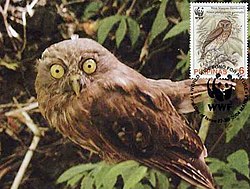| Luzon boobook | |
|---|---|
 | |
| Ninox philippensis philippinensis seen in Laguna | |
| Scientific classification | |
| Kingdom: | Animalia |
| Phylum: | Chordata |
| Class: | Aves |
| Order: | Strigiformes |
| Family: | Strigidae |
| Genus: | Ninox |
| Species complex: | Philippine hawk-owl species complex |
| Species: | N. philippensis |
| Binomial name | |
| Ninox philippensis Bonaparte, 1855 | |
 | |
| Brown: Luzon Hawk Owl Ninox philippensis, including N. p. ticaoensis and N. p. centralis | |
The Luzon boobook (Ninox philippensis) or Luzon hawk owl, also Philippine hawk owl or Philippine boobook, is a species of owl in the family Strigidae. It is endemic to the Philippines where it lives in forests. It is a brown and white mottled bird and males and females look much alike.

